Incels Rising International Edition
Completely different picture from the US. Several theories obliterated.
TL;DR
Age of first sexual intercourse has declined since the sexual revolution. The effect is stronger in women than men.
Total sexual partner count, or new partner/s in the past year, is either increasing or stagnant in most countries.
Sexual frequency (how often people have sex) is declining.
Declining marriage rates partially responsible for sex frequency decline.
**Consider reading on the main website uncorrelated and following my X/twitter**
Introduction
We know sexlessness is rising in adolescence based on the YRBSS, GSS and to a lesser extent the NSFG.
But there's a problem with all these datasets they're all American!!!
While the US data has received the most attention, particularly from incel communities, we shouldn't assume these trends are universal across all developed nations.
Naturally, as a result of this, many have generated causal theories attempting to explain rising youth sexlessness. These range from ideological conflicts between the genders, Chadopoly and dating apps (pushed by Incels), and some tech based ones with smart phones and social media (pushed by Jean Twenge), Jonathan Haidt).
What underpins most causal explanations is that they could be applied to any developed country; everyone has access to dating apps, smartphones, left/right political divides are almost everywhere, and there's decent evidence mental illness is on the rise internationally too.
Any theory attempting to explain a cause assumes that there is something to explain in the first place. If there is no increase, decrease, correlation, etc, then there's nothing for the cause explain.
So if we demonstrate the macro timeseries trends for sexlessness are null or contra the US internationally, we can at least increase skepticism of these explanations.
Sexlessness, Internationally
To this end, we will attempt to investigate the long running trends in sexlessness. Once again, we are interested in the key variables:
1. Age at first sex
2. Sexual frequency
3. Lifetime partner counts
Unfortunately, ~~all~~ most datasets from around the globe measuring sex analogous to their US counterparts are behind ethics committees.
So we have to rely on what's reported by academics in the literature specific to each dataset for every country.
United Kingdom
United Kingdom (NATSAL)
NATSAL is a well resourced, representative survey conducted decennially. NATSAL focuses on a broader age range, rather than adolescents.
Overall, 15 162 interviews were completed, with a response rate of 57.7% and a cooperation rate of 65.8%. The response rate for the boost sample of ages 16–34 years was 64.8%, only marginally lower than the 65.4% achieved for Natsal-2, which surveyed a similar age range (16–44). The data were weighted by age, gender and region to reduce possible bias. Comparisons with census data show the weighted sample to provide good representation on a range of respondent characteristics. The interview involved a combination of face-to-face and self-completion components, both carried out on computer
NATSAL has conducted five surveys between 1990-2024, with results from the latest NATSAL-4 (2022-2024) still pending publication
Unfortunately, there are no relevant publications on sexual behavior for the latest survey NATSAL-4. Although publications are expected over the next few years.
Our first paper (Hawes et al., 2010) doesn't have the latest NATSALs but covers papers reviewing age at first sex. Given its age it's now more a historical review of changing virginity post sexual revolution.
In recent decades, the age at which young people become sexually active has fallen (Schubotz et al., 2004; Wellings & Field, 1996; Wellings et al., 2001). Median age at first intercourse was 17 years among the 40- to 44-year-old age group in NATSAL 2000 for both men and women (Wellings et al., 2001). The proportion of women reporting first intercourse before 16 years has increased over recent decades, although
not since the mid 1990s (Wellings et al., 2001). Studies also report on the gender differential in timing of first sexual intercourse, and several studies (Blenkinsop et al., 2004; Currie et al., 2004; Currie & Todd, 1993; Lenciauskiene & Zaborskis, 2008; Wight et al., 2008), but not all (Wellings et al., 2001), have found a higher proportion of girls having had sex by age 16, compared with boys.
Our second paper (Mercer et al., 2013) looks at NATSALs 1 through 3. They provide nice tables with overviews. We will go through the relevant points so you don't have to. All findings are age adjusted.
Lifetime sexual partners increased substantially for women, but less so for men. These changes plateaued between 2000 and 2010.
Number of partners in the last year changed between 1990 and 2000 for men and women but changes ceased 2000 to 2010.
Sexual frequency substantially declined across all surveys.
There are two more tables that cover cohort effects by sex within the NATSAL-3.
A larger proportion of younger cohorts report losing their virginity before 16 than older cohorts. This is substantial and significant for both men and especially women.
The number of permanent virgins has remained mostly constant at ~2% for men and ~0.5% for women.
Owing to the sexual revolution, as implied for the previous table, partner count has generally increased for females.
The last paper we'll look at (Mitchell et al., 2023) for NATSAL includes the most recent data from COVID.
Partner count dropped between 2010 and COVID, but this could be a COVID effect.
Compared with 10 years previously (Natsal-3), women and men in Natsal-COVID-2 were less likely to report two or more sexual partners in the past year (women: 5.4% vs 13.5%, aOR 0.30, 95% CI 0.25 to 0.36; men: 9.6% vs 19.4%, aOR 0.37, 95% CI 0.31 to 0.43). Similar differences between surveys were observed for numbers of reported new sexual partners for women and men, and for WSW (lesbians) and MSM (gays).
However, as was with all successive NATSALs, sexual frequency continued to decline.
Verdict: Incels falling/stagnation.
Sexual frequency: Declining consistently and significantly between surveys.
Partner counts: Increasing over the decades, especially for women.
Age of first sex: Generally declining across age groups.
Australia
Australia (SSASH)
The Australian National Survey of Secondary Students and Sexual Health or SSASH, established in 1992, has had seven iterations up until 2021.
The latest survey was conducted online, recruiting respondents through social media advertising:
For the 2021 survey, data were collected ... via an online instrument that took an average of 33 minutes to complete.
Promoted via social media advertising ... participants were recruited from Instagram (47.0%, n = 2,740), while 39.0% (n = 2,272) were from Facebook and 7.0% (n = 409) from TikTok ... The final sample included the 6,841 ... 4,459 participants who completed the entire survey.
Given this, it's critical to ensure the sample is representative of the general population. However, it appears they had disproportionately high lesbian, gay, bisexual and female samples:
Wilson et al. (2020) estimate the percentage of the Australian population who identify as LGB to be approximately 3.5%.
The percentage of young people identifying as LGB in this survey is high ... 23.3% (n = 1,586) identified as bisexual, 6.0% (n = 406) as gay or lesbian.
The largest group to respond to the survey were ... female (n = 4,456, 65.1%) ... (27.8%) who identified as male.
While this survey's methodology has limitations in representativeness, its large sample size and longitudinal nature still provide valuable insights. My worry is that variance between survey samples might be quite high to obfuscate trends
The results contradict the US narrative. The Australian youth is enjoying more sex than ever while their incel cousins cope and seethe.
Australia (ASHR)
The Australian Study of Health and Relationships or ASHR, is an Australian wide decennial survey conducted in 2001-2002 (ASHR1), 2012-2013 (ASHR2) and 2022-2023 (ASHR3).
According to their website they claim that analysis and publication was planned for 2024. Now that 2024 is over, they have clearly failed to meet this timeline.
However, there were plenty of papers covering cohort differences between ASHR1 and ASHR2.
The survey is more representative and better sampled than its sister online survey. Quoting from (Rissel, Heywood, et al., 2014)'s brief description of the method.
... computer-assisted telephone interviews were completed by a representative sample of 20,094 Australian residents aged 16–69 years from all states and territories ... Respondents were selected using dual-frame modified random-digit dialling (RDD), combining directory-assisted, landline-based RDD with RDD of mobile telephones. The overall participation rate among eligible people was 66.2%.
8577 completed the long- form interview, and 11 517 completed the short-form interview.
Reading through four papers covering the differences between ASHR1 and ASHR2, (Badcock et al., 2014), (Rissel, Heywood, et al., 2014), (Rissel, Badcock, et al., 2014), and (de Visser et al., 2014). Here were the best quotes and summaries regarding differences across birth cohorts and between surveys.
From the paper 'Characteristics of heterosexual regular relationships among a representative sample of adults', between ASHR1 and ASHR2, there was a decline in sexual frequency.
Finally, respondents in ASHR2 reported a significantly lower average frequency of sex in the past 4 weeks than respondents in ASHR1 (both sexes, P < 0.001). For men, the average frequency of sex declined from 1.86 (CI: 1.76–1.96) to 1.50 (CI: 1.41–1.59) and in women, it declined from 1.82 (CI: 1.72–1.92) to 1.52 (CI: 1.42–1.63).
In 'First vaginal intercourse and oral sex among a representative sample of Australian adults', as one can see from Table 6, the proportions of 16-19 year olds reporting ever having sex did not significantly change for men (p=0.07) and for women (p=0.28).
The paper provides cohort data on the median age of first sex (virginity). It seems like there's a notable post-sexual revolution decline in virginity then a plateau.
The results show a significant decline in the median age of first vaginal intercourse for both men and women among those born between the 1940s and the 1960s, but no further decline since.
For all cohorts, the median age at first sex increased for men, and female lifetime partner count increased. Plausibly the observed trends here stem from the oldest pre-sexual revolution cohorts dying, with post-revolution generations replacing them between surveys.
Verdict: Incels falling/stagnation.
Sexual frequency: Significant declines in ASHR.
Partner counts: General increase in women. Otherwise mostly unchanged.
Age of first sex: Declined in older cohorts.
France
France (CSF)
The introduction to Contexte des Sexualités en France, translated by Google, provides a good overview of France's large sex surveys over time.
A first scientific survey on the sexual behavior of the French was conducted in 1970 among 2,600 people by Pierre Simon and his team (Simon 1972). It was followed in 1992 by the survey “Analysis of sexual behavior in France”, conducted among 20,000 people, under the responsibility of Alfred Spira and Nathalie Bajos (Inserm), then by the survey “Context of sexuality in France” conducted in 2006 among 12,000 people under the responsibility of Nathalie Bajos and Michel Bozon (Ined) in 2006. The last two surveys, initiated and funded by the National Agency for Research on AIDS (ANRS), have given rise to numerous publications (Spira and Bajos, 1993, Bajos et al.; 1998, Bajos and Bozon 2008). The results have helped guide the development of sexual health policies, particularly in the area of HIV infection. The new survey “Context of sexuality in France” (CSF-2023) required 5 years of work. Initiated in the fall of 2019, its schedule was delayed by the Covid-19 pandemic. This document is the first presentation of the methodology and the first results. They are presented for mainland France.
TL;DR, France has four main surveys conducted in 1970, 1992, 2006 and 2023 respectively.
There's a paper published on the first three surveys (Bajos et al., 2010), and the document summarizing the latest survey (Bajos et al., 2024).
In the latter paper, which focuses on the latter three surveys (1992 - 2023, not 1970), they plot the median age virginity is lost by cohort. As we can observe, and as we have seen in studies from other countries, the decline in age of first sex is greatest for women.
Notably, in the recent decade, age of first sex has started to rise again! This is important because the CSF 2023 has data for the last decade unlike the Aussie and British surveys.
Both papers provide two tables on total lifetime partner counts. However, the first paper includes the 1970s survey and excludes 2023s survey, while the second document does the opposite. For convenience, the numbers from both were gathered in one accessible plot.
As can be observed, for women there has been a universal increase in lifetime sexual partner count. Male lifetime counts were mostly stagnant 1970-2006 with the exception of the 2023 survey. The 2023 survey looks suspicious. Keep in mind these are averages not medians.
Finally, and most interestingly, we have sexual frequency broken down by single and partnered status!
The survey finds something that I didn't expect, sex frequency is declining not just overall, but within couples and singles! As I was writing this article, I expected that most of the variance in the decline of sexual frequency could be attributed to the decline in marriage, however, it appears that this is not the case.
The decline it seems is less pronounced over a four week period, than over a year.
Verdict: Incels paradox. Less sex than ever before but with more partners.
Sexual frequency: As measured by sexual activity in the past year, a universal decline across all surveys, even adjusting for relationship status. When only looking at mean sexual encounters in the past 4 weeks, declines only appear in the latest survey.
Partner counts: Increasing over the decades, especially for women. This holds true even for the oldest surveys.
Age of first sex: Generally declining across age groups since the sexual revolution, with the exception for the last decade.
Other Countries
Our primary task was to investigate if US sexlessness trends were comparable to culturally or developmentally similar countries. For this, France, UK and Australia are sufficient, but not exhaustive. The rest of the countries here are low hanging fruit; but have not been systematically reviewed.
Japan
Japan has the 'National Fertility Survey', which has been conducted roughly every 5 years since the 1980s. Its structure is different from the other countries with different aims, as a result, it separately questions never-married and married persons.
There's only one figure in the summary report pertaining to sexlessness broadly. It largely confirms what we observed with France, UK and Australia in that sexual experience seems to have increased for women since the sexual revolution. Other than that, there haven't been many significant changes.
One could argue that declining marriage could be causing a selection effect in the older age groups, however, this cannot be a large effect for the teenagers sampled, as few are married by that age.
Italy
A study on Italian University students looked at the correlates of virginity in surveys from 2000 and 2017. They find virginity rates falling, which is not surprising given the results we've seen particularly in the UK.
Scandinavia
A Scandinavian study (Hansen et al. 2019) measured sexual behaviors among 100k women in Sweden, Denmark and Norway.
Mostly the same observations as other countries, that lifetime partner counts had increased among women.
Our findings show a largely stable debut age among the cohorts born during the 1960s and 1970s, with median age at first intercourse of 16 for most of the Danish cohorts, and 17 for most of the Norwegian and Swedish cohorts... Our study further demonstrated a shift towards earlier first intercourse in younger female birth cohorts (born 1983-1994), to a median debut age of 16 in all countries
The overall median (interquartile range) number of lifetime sexual partners among women in Denmark, Norway, and Sweden were 6 (3-10), 5 (2-10), and 6 (3-11), respectively... the proportion of women who reported >10 sexual partners was higher in 2012 than in 2005 in all age groups and in all countries
The Rest
The NATSAL had a 'scoping review' where in the appendix it conveniently lists population sex surveys from around the world. Countries not covered that are listed here include New Zealand, Ireland, Slovenia, South Africa, and Spain. There's also a study on Germany finding sexual declines. From memory Nuance Pill had a post with a similar summary, however, I've not been able to locate it.
It should be noted that Durex, the condom company, conducts well resourced international surveys of sexual behavior across dozens of countries every year or so. I could only find three reports that they published online; and it would seem this would be an excellent resource, but it seems mostly closed source.
Conclusion, Discussion
Is Declining Sexual Frequency Mostly Declining Marriage?
An interesting phenomena or perhaps even a paradox is that the number of lifetime sexual partners is increasing, the age of intercourse is falling, there's more sexual liberty and acceptance of sexual minorities than ever, however, despite all this, sexual frequency is declining.
My simple theory is that most of the decline in sexual frequency can be reduced to the decline of relationships and marriage.
Very simply, using the GSS we can measure the standardized age and sex adjusted difference in quantified sexual frequency. The difference is small, but still significant at -0.267 standard deviations.
As was seen in the French data, there's also a slightly significant effect by birth cohort. In the GSS it's about -0.00204 standard deviations per year, or across 50 years (e.g. born in 1950 vs 2000) about -0.102 standard deviations.
So ballpark estimate a total difference of about 0.3 standard deviations (ignoring the multiple assumptions we just made) could be explained between the oldest surveys with the oldest cohorts and youngest cohorts in the latest surveys. Again, this is due to a small cohort effect and a marriage effect.
This theory makes sense because declining marriage rates wouldn't affect the age at which one loses their virginity. Furthermore, less serious long term relationships substituted for short term flings would result in higher lifetime partner counts too - which is exactly what we see happening in the data. However, once again, the effect of declining marriage seems insufficient to account for the reported declines.
Closing thoughts
This review has been enlightening. Judging just from the US data which shows multi decadal declines in sexual behavior across multiple datasets, I was anticipating finding roughly the same trends. However, the conclusions were more nuanced. Men and especially women are losing their virginities sooner, have more sexual partners and greater diversity of sexual experiences, but less often.
The data reveals several interesting paradoxes. While sexual liberation has continued its march forward - with decreasing ages of first sexual experience and increasing lifetime partner counts - actual sexual frequency has declined consistently across surveyed nations. This pattern holds true even when controlling for relationship status, suggesting deeper societal shifts beyond just declining marriage rates.
The French data is particularly revealing, showing sexual frequency declining not just among singles but within established couples too. This contradicts the simple narrative that modern dating apps and changing relationship dynamics are solely responsible for observed changes in sexual behavior.
Notably, the trends differ markedly between genders. Women have seen the most dramatic changes since the sexual revolution, with substantial increases in lifetime partner counts and earlier sexual debuts. Male patterns, by contrast, have remained relatively stable outside of the overall frequency decline.
Annoyingly, the UK and Australian datasets haven't published their findings despite sitting on it for over a year. What's worse is that directly on their website they promised publication last year. These newer datasets could be crucial for understanding post-2020 trends, especially given the French data suggesting possible accelerated declines in recent years. With increasing digitization and changes in social patterns, we might be seeing the emergence of new behavioral patterns that older datasets can't capture.
The international perspective ultimately challenges many common explanations for changing sexual behavior. Popular theories about dating apps, smartphones, or gender dynamics struggle to explain why different countries show such varying patterns despite similar technological and social changes. This suggests we need more nuanced frameworks for understanding these trends rather than universal explanations based solely on US data.


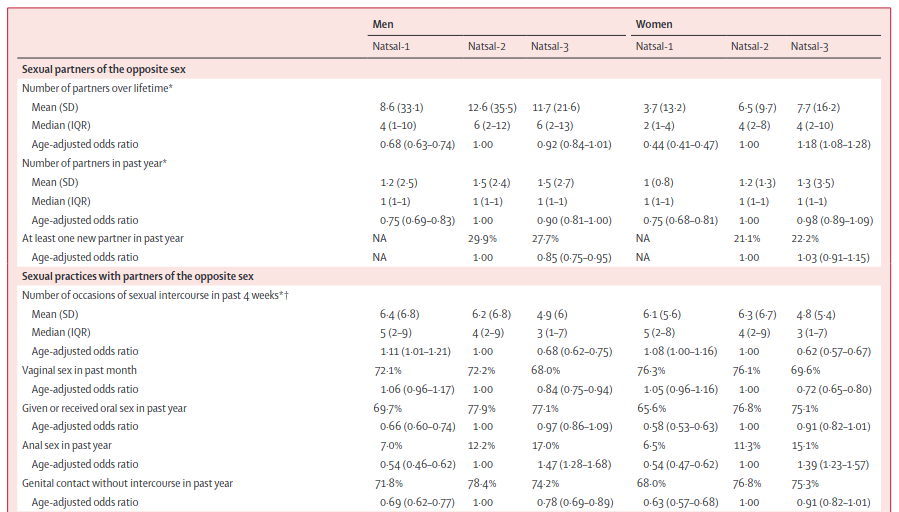
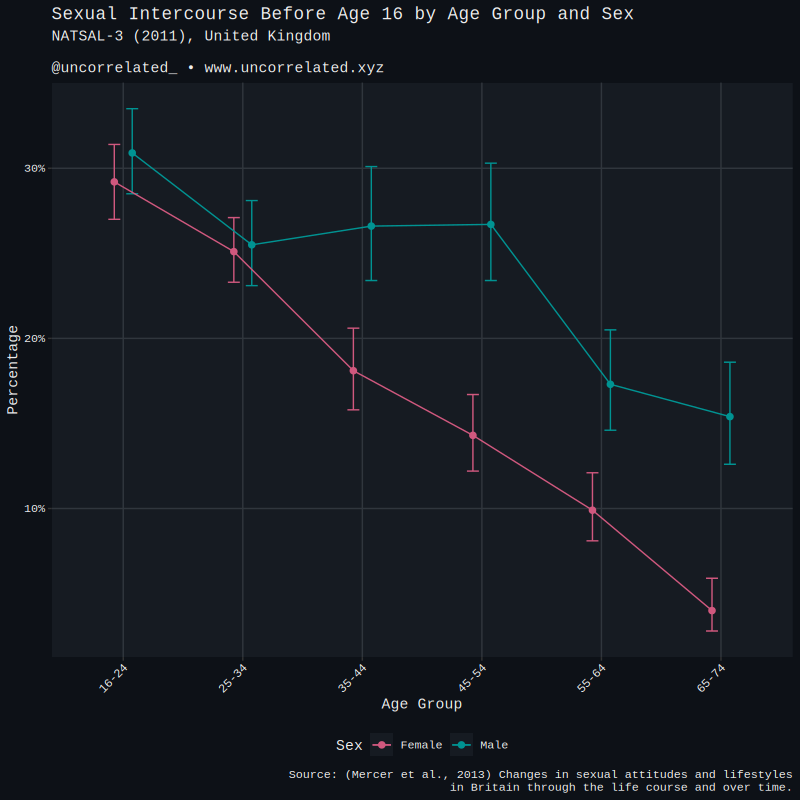
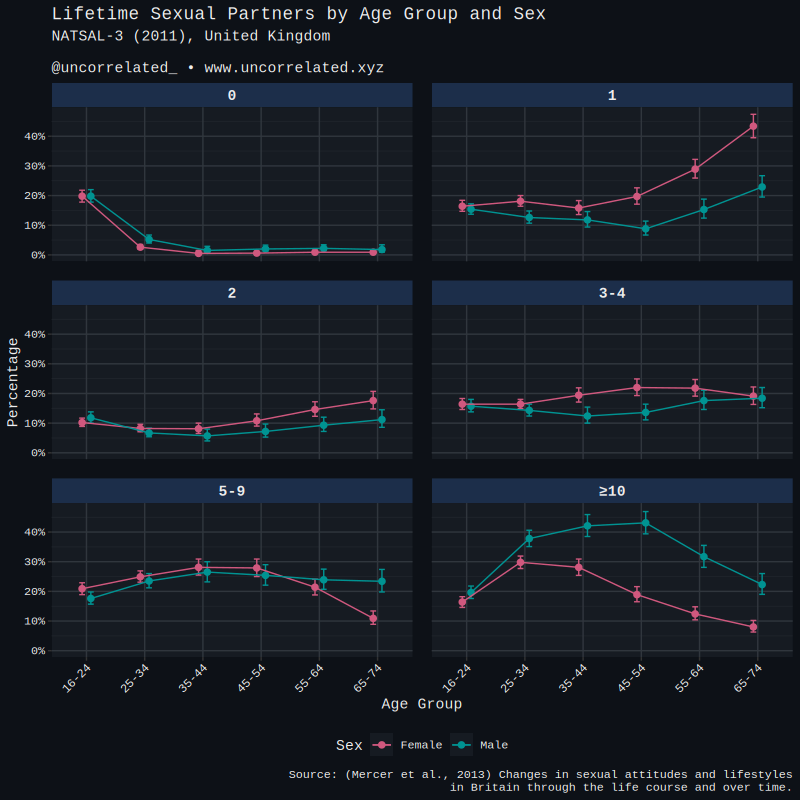
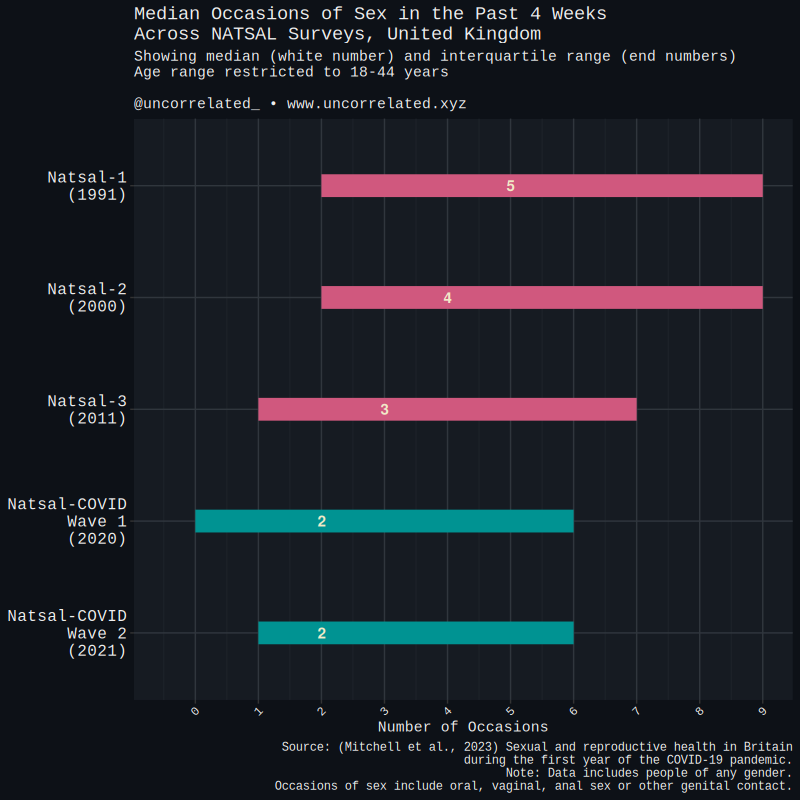
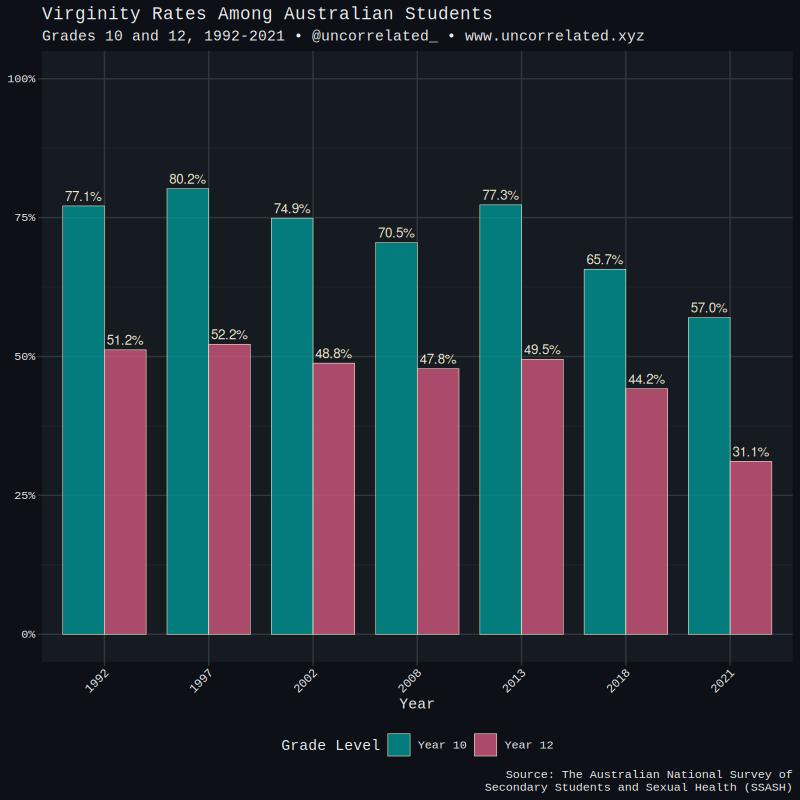
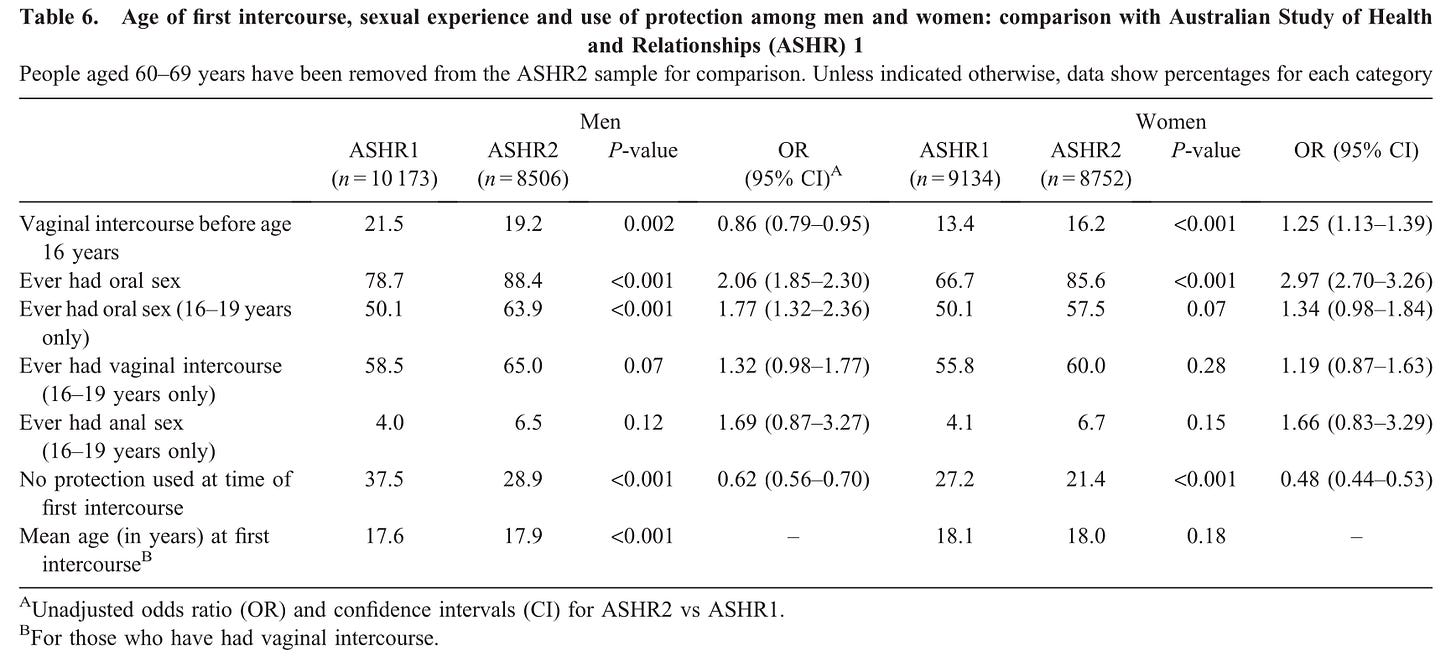

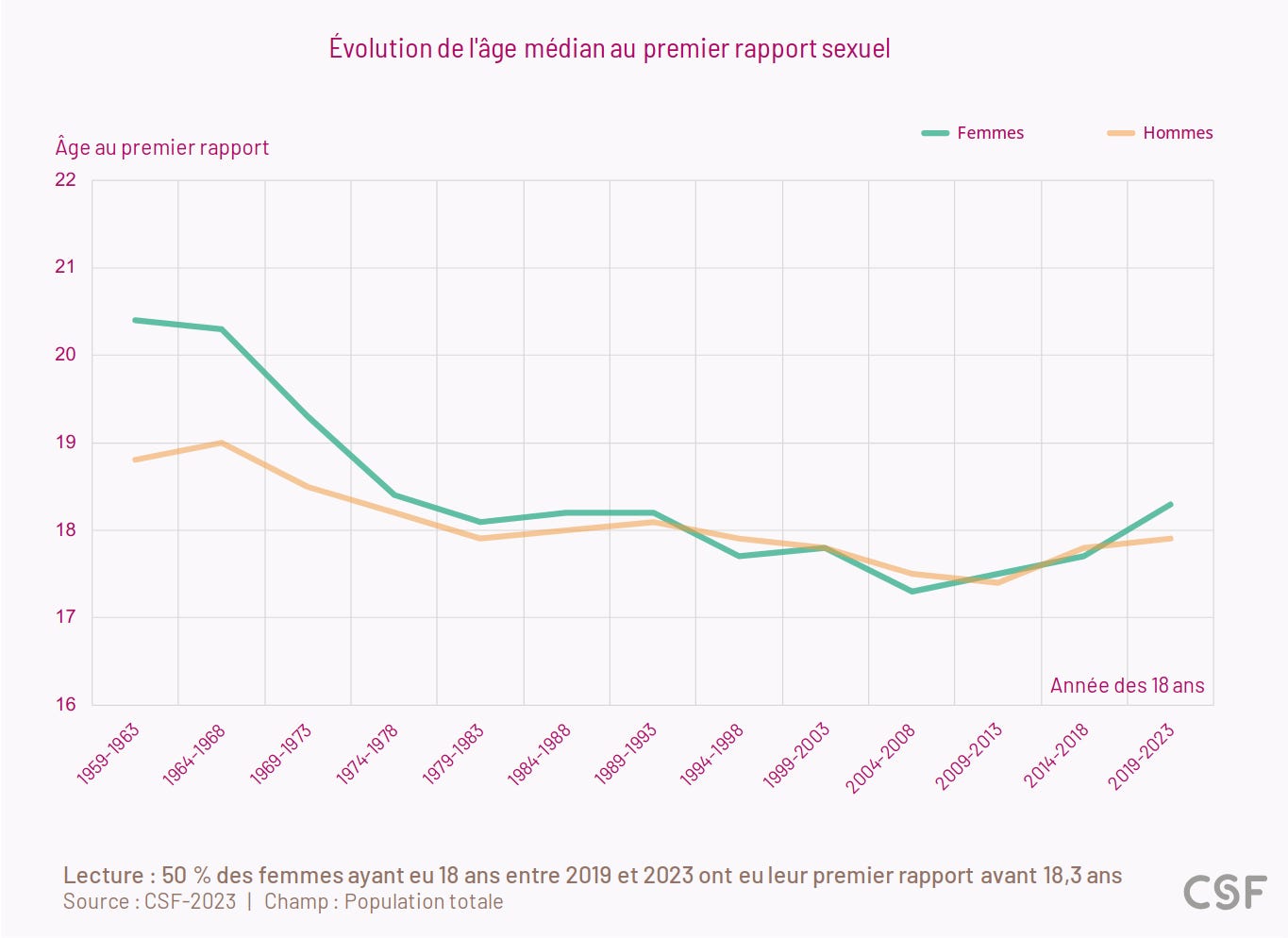
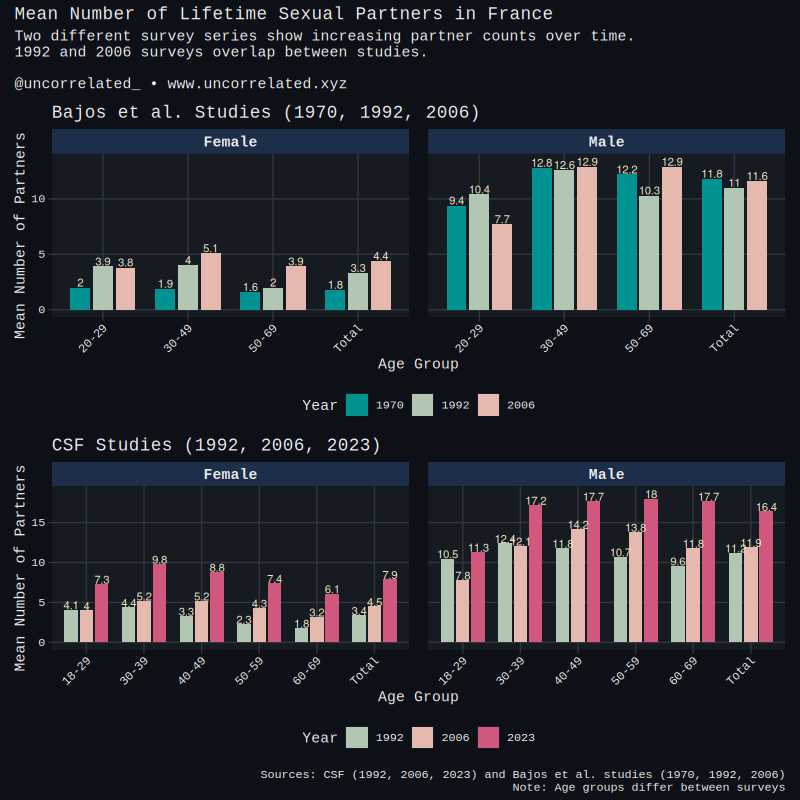
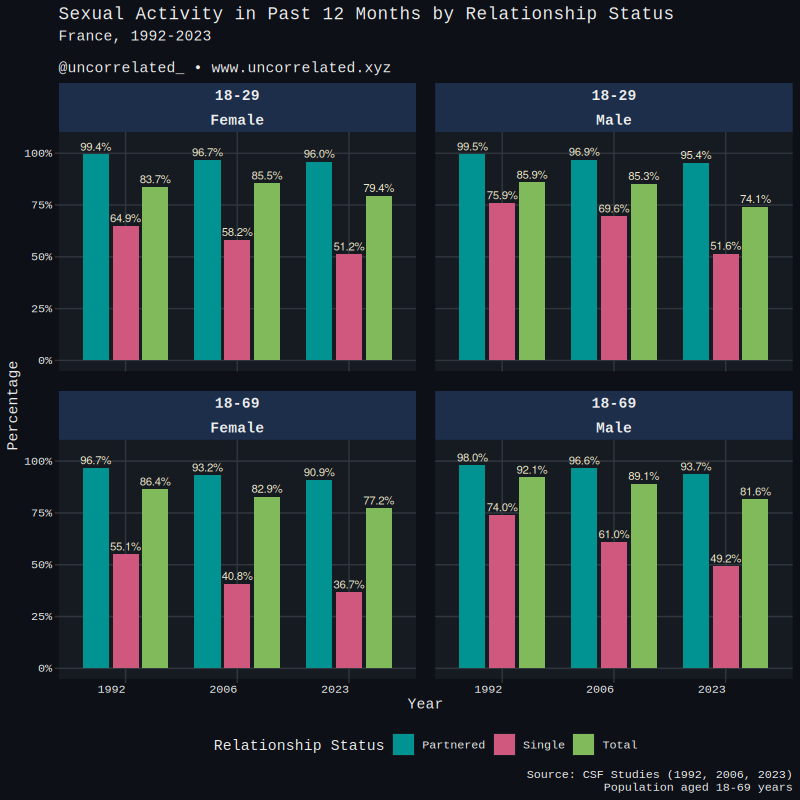



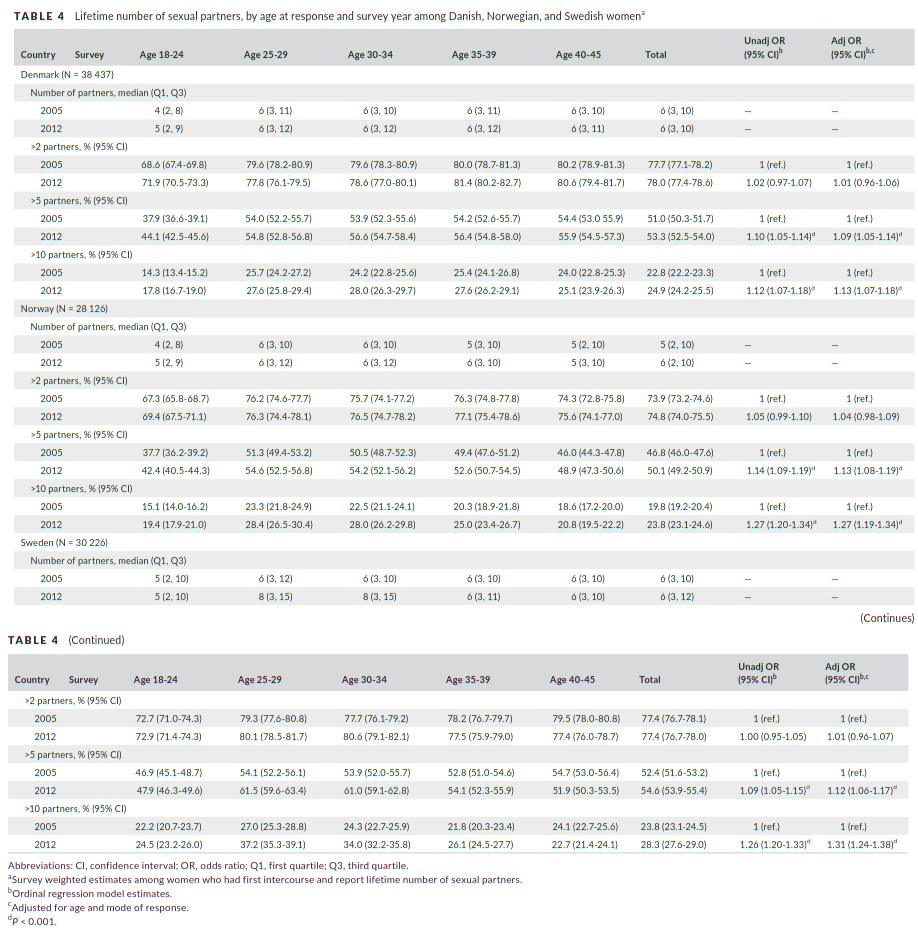

Thank you for a very interesting post on a fascinating topic. I want to take issue, however, with your conclusion that international trends in sexlessness yield a “completely different picture from the US”. I don’t think such a conclusion is warranted, at least as regards the three key variables you investigate: age at first sex, sexual frequency, and lifetime partner counts.
First, as regards age at first sex, a recent review of trends in age of sexual initiation in 33 European countries between 2010 and 2018 (de Graaf et al., 2024, https://www.tandfonline.com/doi/full/10.1080/00224499.2023.2297906) found that in virtually every country early sexual initiation (by the age of 15) had decreased (Table 1), suggesting that average age at first sex has likely been increasing over the last 10-15 years, in a reversal of the previous trend. The same trend was also documented earlier in two European countries: Scotland (Neville et al., 2017; https://academic.oup.com/eurpub/article/27/5/835/3603403; Table 2) and Portugal (Reis et al., 2019; https://karger.com/pjp/article/36/1/32/274974/Trends-in-Portuguese-Adolescents-Sexual-Behavior; Table 2). It may be therefore that many countries are now experiencing the same trend towards adolescent sexlessness as the USA, and that the only difference is one of timing, with the trend first starting in the USA in the mid/late-1990s (Finer & Philbin, 2014, https://pmc.ncbi.nlm.nih.gov/articles/PMC4011992/; Figures 1 and 2), then in certain European countries (and Japan, according to the study you cite) in the early 2000s, and then in other European countries over the following 15 years or so. (The findings you report for Australia from SSAHS suggest that Australian adolescents have bucked this trend, but as you say they may not be reliable, and so need to be confirmed by ASHR3).
Second, as regards sexual frequency, as you note, it has declined since the 1990s or early 2000s in all five countries for which you cite study findings (Australia, France, Germany, UK, USA), and there are also similar findings from Finland (Kontula, 2015, https://www.researchgate.net/publication/304193379_Sex_Life_Challenges_The_Finnish_Case) and Japan (Wellings et al., 2019, https://www.bmj.com/content/bmj/365/bmj.l1525.full.pdf; reference 4). The finding you “didn’t expect” from France that declines have occurred in both married/cohabiting adults as well as singles is however also documented in the USA (Twenge et al., 2017, https://www.researchgate.net/publication/314273096_Declines_in_Sexual_Frequency_among_American_Adults_1989-2014; Figure 2), as well as the UK (Wellings et al., 2019; Figure 2 and Tables 1 and 2), and Finland (Kontula, 2015; pp. 688-689). (There appear to be no available findings for Australia, Germany, and Japan).
Finally, as regards lifetime partner counts, as you show, they have increased in recent decades in all the countries you mention (France, the Scandinavian Countries, and the UK), particularly for women, but they have also increased in the USA (Twenge et al., 2015, https://www.researchgate.net/publication/275895690_Changes_in_American_Adults'_Sexual_Behavior_and_Attitudes_1972-2012; Tables 1 and 2). The “paradox” of increasing partner counts but lesser sexual activity is therefore present in the US findings as well as the international findings. However, while the trends may be real, the reported numbers are almost certainly not, given the very large and therefore almost certainly impossible gender disparities (Mitchell et al. 2018; https://www.tandfonline.com/doi/full/10.1080/00224499.2018.1481193), so it’s difficult to know what to make of the findings.
In conclusion, I think the international findings point in the same direction as the US findings, and suggest that there is a real global phenomenon of rising sexlessness, likely due to the same factors, though operating over slightly different time-periods.
>Women have seen the most dramatic changes since the sexual revolution, with substantial increases in lifetime partner counts
Average number of partners can't differ much by gender, because each new sex act increases count by same amount for each gender. It seems that women did grossly underreport number of sexual partners and degree of underreporting is smaller now.